Developing Sanitation Guidelines and Policies for the World's Waterways
- Nicholas M. Kiulia
- Doctoral Student
- Department of Fisheries and Wildlife
- College of Agriculture and Natural Resources
- Joan B. Rose
- Homer E. Nowlin Chair in Water Research
- Department of Fisheries and Wildlife
- College of Agriculture and Natural Resources
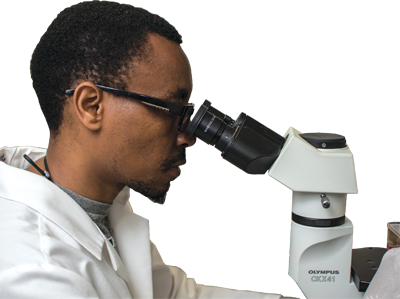
Nicholas Kiulia observes infected cultures for cytopathic effect (CPE) at Joan Rose's lab in the Plant and Soil Sciences Building.
Some people think big while others focus at a much more detailed level. Nicholas Kiulia's research reflects both ends of the spectrum.
Nicholas Kiulia is a doctoral student and molecular virologist working on the United Nations Educational, Scientific, and Cultural Organization (UNESCO) Global Water Pathogen Project (GWPP). He grew up in Meru, Kenya, and later moved to Nairobi for his undergraduate degree. Kiulia has had a long collaboration (since 2005) with the University of Pretoria, South Africa, as a student and visiting researcher.
In 2014 Kiulia was awarded a fellowship by the Midland Research Institute for Value Chain Creation to pursue doctoral studies at MSU under the guidance and mentorship of Joan Rose, one of the world's foremost experts on microbial risk to human health from contaminated water. Kiulia's work with Rose and a team of MSU researchers contributes to a worldwide partnership composed of more than 150 renowned scientists working together to develop quantitative data about sanitation to help guide policies for global use.
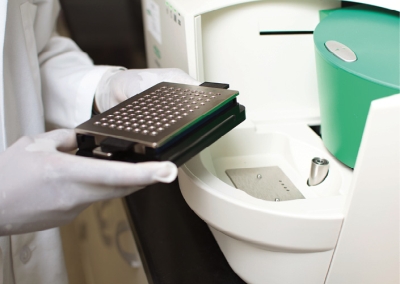
Preparing samples for droplet digital polymerase chain reaction (dPCR) experiments to quantify and detect enteric virus in untreated sewage water samples.
Kiulia's research, which focuses on human enteric viruses that affect public health, is addressing risk assessment of water sources and raw foods associated with viral disease transmission. He studies viruses in the water environment using new molecular tools and applies a modeling approach to trace where problems originate. His goal is to prevent waterborne disease outbreaks by providing scientists and communities with a better understanding of the contamination pathways that contribute to the spread of viral diseases.
MSU is a key partner working with the World Health Organization (WHO) and their development of a sanitation guideline and policy document applicable for worldwide use.
Dr. Rose's leadership on the project encouraged Kiulia to join the team in developing research models that assess virus-travel pathways where no monitoring data are available.
Contaminated water creates unhealthy and dangerous public health conditions. Enteric viruses such as rotavirus are transmitted from fecal matter through oral ingestion. They can cause acute gastroenteritis and even death in infants, young children, and vulnerable adult populations. The 2014 WHO/UNICEF report, Progress on Drinking Water and Sanitation: Joint Monitoring Programme Update 2014,[1] estimates that almost 85 percent of the world's total wastewater is discharged without adequate treatment, if any treatment at all. It is estimated that two and a half billion people do not have access to improved sanitation, and that one billion people still practice open defecation.
Joan B. Rose, Ph.D.
Homer Nowlin Endowed Chair for Water Research
Joan Rose came to Michigan State University in 2003, and since 2005 she has served as a co-director for the Center for Water Sciences and the Center for Advancing Microbial Risk Assessment. She operates the Water Quality, Environmental and Molecular Microbiology Laboratory, conducting general water quality testing in one lab and environmental molecular microbiology analysis in a second lab.
She was the first person to present a method for detecting the microorganism Cryptosporidium, and has become an international authority on examination of full-scale water treatment systems for the removal of pathogens.
Highly regarded as a water microbiologist and public health leader, Rose was awarded the 2016 Stockholm Water Prize celebrated in Switzerland at the World Water Week. It is the most prestigious recognition in the world that individuals or organizations can receive for water-related achievements, and honors those whose work contributes to the conservation and protection of water resources, and to the well-being of the planet.
The "Grand Challenge"
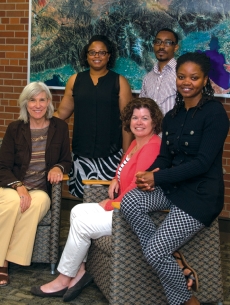
MSU members of the Global Water Pathogen Project. From left: Joan Rose, Jade Mitchell, Erin Dreelin, Nicholas Kiulia, and Kyana Young. Not pictured: Wietske Van Osch.
UNESCO supports world peace by building networks among nations to enable moral and intellectual solidarity. Clean water is one of the most widely agreed upon basic human rights. The Global Water Pathogen Project's vision is to translate science on global water pathogens, sanitation, and health into practices that restore and protect water safety, thus contributing to the advancement of healthy, peaceful communities.
Dr. Rose and Dr. Blanca Jiménez-Cisneros, secretary of UNESCO's International Hydrological Programme, are the principal leaders for the GWPP. Together, they are dedicated to building and enhancing the network by utilizing broad scientific expertise, balanced geographic representation, and gender equality.
"Safe water is a very complex challenge," said Rose. "Water resource management and land use are intertwined, and we need involvement from higher education, industry, and public policy decision makers to participate in the challenges related to water security."
Rose and Jiménez-Cisneros identify two major goals for the GWPP network. The first is to publish and disseminate a state-of-the-art reference work on water-related disease risks and intervention measures that updates the 1983 book, Sanitation and Disease: Health Aspects of Excreta and Wastewater Management, by Feachem, Bradley, Garelick, and Mara. This publication has long been the standard resource for waterborne pathogen information. The GWPP network has identified approximately 100 authors to contribute to an updated reference publication and online resource in English, French, and Spanish.
"The 1983 publication played a key role in addressing the incidence of water-related diseases and providing the most comprehensive overview of fecal indicators and pathogen occurrence in the environment. It is very important that we now update the content because of the profound increase in knowledge, data, and technology capabilities during the last 35-plus years," said Rose.
Their second goal is to create an online open-access resource that will connect user communities in the professional, government, business, and civil sectors with data and information from leading scientists. The aim is to share information that will encourage public education and participation for safe, clean water in communities.
Support from the Midland Research Institute for Value Chain Creation
"UNESCO has a very broad perspective. You need to link it all together to present a holistic approach. We promote that holistic approach with international cooperation, capacity building, and research projects."
Blanca Jiménez-Cisneros
Secretary of the International Hydrological Programme
United Nations Educational, Scientific, and Cultural Organization (UNESCO)
MSU's Midland Research Institute for Value Chain Creation in the Eli Broad College of Business is funding Kiulia's research.
"The work aligns with the Dow Company's philanthropic goals for addressing safe water worldwide. It also supports other major international goals, particularly UNESCO's goal to address education and exchange of knowledge," said Kiulia.
As part of the GWPP, Kiulia's project goal is to develop a knowledge supply chain for safe water, particularly regarding rotavirus, using advanced information technology. While Kiulia studies global viral water pollution and is involved in accessing and organizing the data, another piece of the project is working on social media tools for raising awareness and participation with the network.[2] This will create an accessible resource that can be utilized for educational opportunities anywhere in the world where water issues are addressed.
The project aims to supply information to scientific colleagues, engineers, non-governmental organizations, policy experts, government officials, and industry leaders. The work has attracted attention from the DOW Chemical Company, Proctor & Gamble, the American Chemistry Council, and the Bill and Melinda Gates Foundation. Acknowledging that more industry leaders need to be brought in, Rose and the GWPP team are working to expand involvement.
"We scheduled four user community meetings, England, North Carolina, Tanzania, and Australia, each on a different continent. They corresponded with other events; for example, the October meeting in Brisbane was scheduled because of the International World Water Congress and Exhibition 2016. The goal is to inform as many people as possible," said Rose.
The Global Water Pathogen Project
Principal Investigators and Core Team Members
- Joan Rose, Nowlin Chair in Water Research, Department of Fisheries and Wildlife, MSU
- Blanca Jiménez-Cisneros, Director, Division of Water Sciences, UNESCO
- Gertjan Medema, Principal Microbiologist, Chief Science Officer, KWR Watercycle Research Institute, Netherlands
MSU Team
- Erin Dreelin, Associate Director, Center for Water Sciences, Department of Fisheries and Wildlife
- Jade Mitchell, Assistant Professor, Department of Biosystems and Agricultural Engineering
- Wietske van Osch, Assistant Professor, Department of Media and Information
- Kyana Young, Research Associate, Department of Fisheries and Wildlife
- Nicholas Kiulia, Doctoral Student, Department of Fisheries and Wildlife
Mapping Rotaviruses and the Systemic Modeling Approach
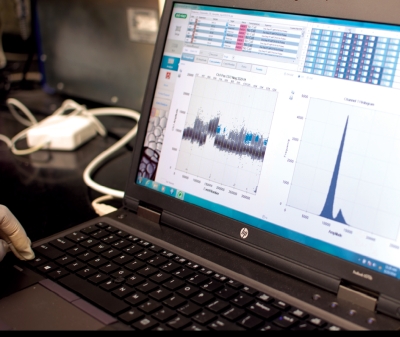
Digital PCR viral concentration results can be used for quantitative microbial risk analysis (QMRA) to estimate the risk from exposure to viral pathogens and also for spatial predictive modeling to estimate the global emission of rotavirus from human wastewater to surface waters.

Nicholas Kiulia collects untreated sewage samples from a lagoon in Kenya using a novel bag-mediated filtration system (BMFS), a technique being evaluated by WHO for environmental surveillance for polioviruses in developing countries.
In 2015, Kiulia, Rose, and a research team that included Nynke Hofstra, Lucie C. Vermeulen, Maureen A. Obara, and Gertjan Medema published "Global Occurrence and Emission of Rotaviruses to Surface Waters" in the journal Pathogens.[3] The authors noted that as far as they knew, their global waterborne pathogen model was the first attempt to estimate the global distribution of rotavirus emissions to surface water.
According to Rose, systems modeling provides global scope for assessing potential problem areas where the viruses originate, and where they can travel.
"The systems modeling approach provides valuable information about where 'contamination hotspots' are occurring, and where those pathogens can potentially travel along in the waterways," said Rose.
"One of the most frequent questions asked by people experiencing contamination in their communities is 'Where did this come from?' As technology and science improves, we are able to provide more—and more reliable—data," she said.
The collaborative piece of Kiulia's project involves using advanced information technology to supply information to scientists, industry and government leaders, policy experts, and involved citizens.
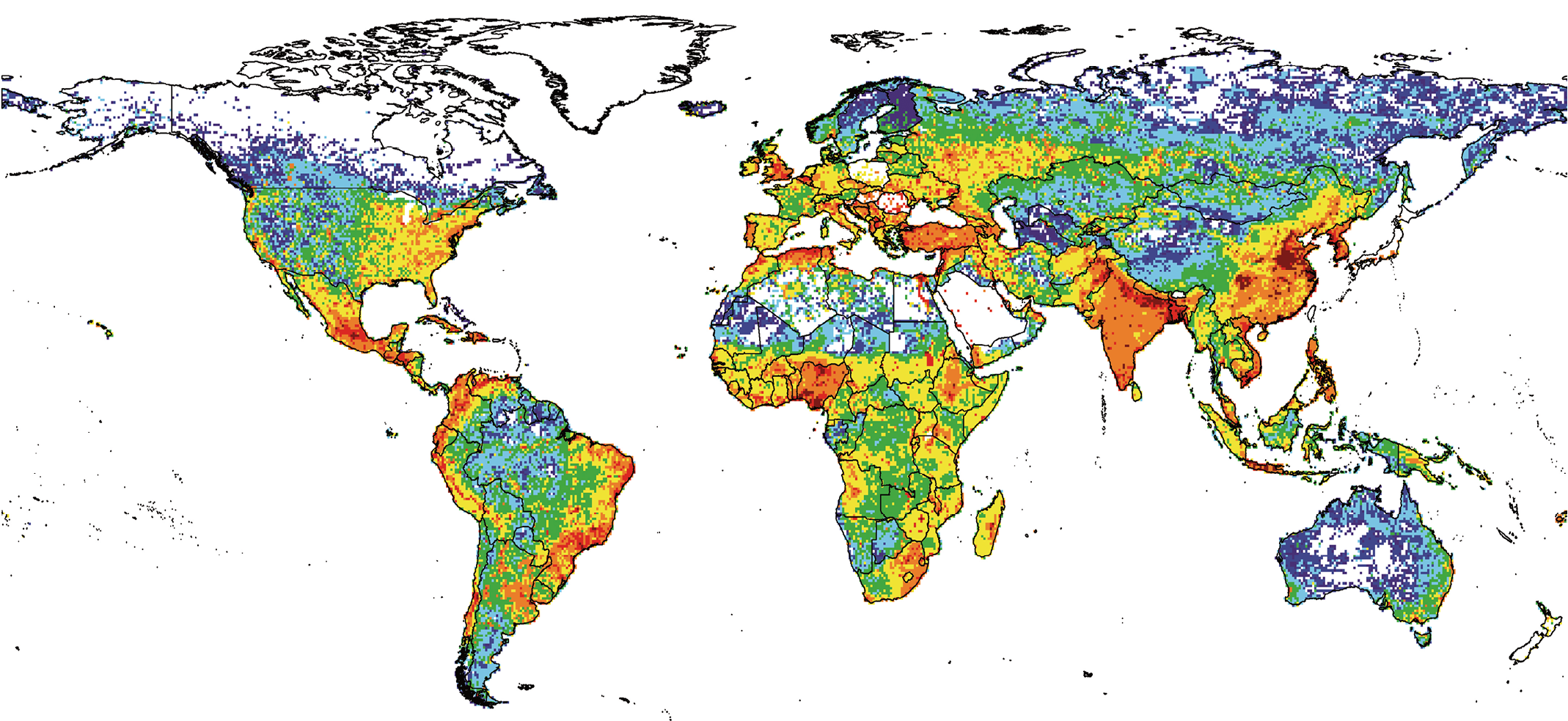
Mapping by Kiulia illustrates total rotavirus emissions in viral particles, produced worldwide by the urban population during 2010. Based on the systems modeling approach, maps and data supplied to communities can be used to discuss decisions on risk mitigation and wastewater treatment.
"If we have a knowledge system for safe water, it can support global exposure assessments and enable evaluation of sanitation technologies for achieving health-based targets," said Kiulia. "Transparent and accessible data and information that is available to everyone can stimulate education and cooperation. If we have quantitative values from the scientific data it can be used for setting practical sanitation requirements," Kiulia said.
"There is stress on global waters. We are working with UNESCO to build a global network where we can facilitate education and intercultural understanding," said Rose.
Kiulia is committed to scientific discovery that contributes to society. "I will be translating the knowledge that I acquire over the years to help the Kenyan government develop water safety related policies. Kenya is prone to water-borne diseases due to flooding, and I want to participate in the scientific and community strategies for reduction of diseases such as cholera, rotavirus, and the others. I want to help show the importance of having a proper waste water treatment plan," he said.
Because he deals with each end of the spectrum, a normal day finds Kiulia dividing his time between meetings, conference calls, and paperwork in an office at the Manley Miles Building, and studying viruses in a lab across campus at the Plant and Soil Sciences Building. How does he transition from thinking broadly about global water concerns to painstakingly detailed work with a microscope, sophisticated laboratory equipment and odious viruses? You can find Kiulia riding his bike.
"I like the fresh air," he said, smiling.
Midland Research Institute for Value Chain Creation
The idea of a value chain is based on the process view of organizations, seeing a manufacturing (or service) organization as a system, made up of subsystems each with inputs, transformation processes, and outputs. How value chain activities are carried out determines costs and affects profits.[4]
The Midland Research Institute for Value Chain Creation was established by Michigan State University in 2013 to develop ways to improve all types of public and private value chains.
The institute builds on MSU's strong interdisciplinary research capabilities by linking faculty from the Broad College of Business, the College of Engineering, the College of Agriculture and Natural Resources, and the College of Social Science in research on topics such as resource management, analytics, security, and sustainability. MSU's top-ranked Department of Supply Chain Management provides comprehensive leadership to the initiative.
In addition to conducting research, the institute also offers graduate studies in supply chain management as well as non-degree courses and certificate programs, lectures, and seminars both online and at the Midland facility.
Initial support was provided through generous donations from Midland-based companies Dow Chemical and Dow Corning and local foundations, including the Dow Chemical Company Foundation, the Herbert H. and Grace A. Dow Foundation, the Rollin M. Gerstacker Foundation, and the Charles J. Strosacker Foundation.
A technical advisory board composed of MSU and corporate partners helps set the research agenda of the institute.
Sources
- WHO/UNICEF. (2014, May). Progress on drinking water and sanitation: Joint Monitoring Programme update 2014. Available from http://www.who.int/water_sanitation_health/publications/2014/jmp-report/en/Return to text
- UNESCO, Agroknow, & MSU Midland Research Institute for Value Chain Creation. (2015). Global Water Pathogen Project: Vision [web page]. Retrieved August 19, 2016 from http://www.waterpathogens.org/node/19Return to text
- Kiulia, N. M., Hofstra, N., Vermeulen, L. C., Obara, M. A., Medema, G., & Rose, J. B. (2015). Global occurrence and emission of rotaviruses to surface waters. Pathogens, 4, 229-255. Retrieved from http://www.mdpi.com/2076-0817/4/2/229/htmReturn to text
- Porter, M. E. (1985). Competitive advantage: Creating and sustaining superior performance. New York: Simon and Schuster.Return to text
- Written by Carla Hills, University Outreach and Engagement